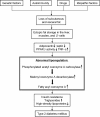A case of acquired generalized lipodystrophy with cerebellar degeneration and type 2 diabetes mellitus
- PMID: 17491704
- PMCID: PMC1783692
- DOI: 10.1900/RDS.2004.1.193
A case of acquired generalized lipodystrophy with cerebellar degeneration and type 2 diabetes mellitus
Abstract
Acquired generalized lipodystrophy (AGL) is a rare disorder of adipose tissue characterized by loss of fat from large regions of the body, occurring after birth. Its etiology remains unknown. Most AGL patients have had fasting and/or postprandial hyperinsulinemia, diabetes mellitus, hypertriglyceridemia, and fatty liver. We describe the case of a 30-year-old woman with a progressively unsteady gait and a generalized loss of body fat beginning at the age of 7. Cerebellar degeneration was revealed by imaging study, and the patient was eventually bedridden at the age of 15, due to progressive ataxia. She developed diabetes at the age of 25 without the presence of any evidence of ketoacidosis. The glutamic acid decarboxylase antibody was negative, C-peptide level 3.6 ng/ml, HbA1c 13%, triglyceride 412 mg/dl, total cholesterol 196 mg/dl, high-density lipoprotein-cholesterol 28 mg/dl, adiponectin 0.76 microg/ml, and resistin was 22.8 ng/ml at the initial state of diabetes. AGL accompanied by type 2 diabetes and cerebellar degeneration was diagnosed on the basis of the clinical features and metabolic derangements.
Figures


Similar articles
-
Clinical features and metabolic derangements in acquired generalized lipodystrophy: case reports and review of the literature.Medicine (Baltimore). 2003 Mar;82(2):129-46. doi: 10.1097/00005792-200303000-00007. Medicine (Baltimore). 2003. PMID: 12640189 Review.
-
Case Report of Acquired Generalized Lipodystrophy Associated With Common Variable Immunodeficiency.J Clin Endocrinol Metab. 2018 Aug 1;103(8):2807-2810. doi: 10.1210/jc.2018-00494. J Clin Endocrinol Metab. 2018. PMID: 29846625
-
Lipoatrophic diabetes in an elderly woman: clinical course and serum adipocytokine concentrations.Endocr J. 2004 Jun;51(3):279-86. doi: 10.1507/endocrj.51.279. Endocr J. 2004. PMID: 15256772
-
Metreleptin Supplementation for Improving Lipid and Glycemic Profiles in Acquired Diabetes Lipodystrophy: A Case Report.J Endocr Soc. 2019 Sep 16;3(11):2179-2183. doi: 10.1210/js.2019-00251. eCollection 2019 Nov 1. J Endocr Soc. 2019. PMID: 31720553 Free PMC article.
-
Lipodystrophies.Am J Med. 2000 Feb;108(2):143-52. doi: 10.1016/s0002-9343(99)00414-3. Am J Med. 2000. PMID: 11126308 Review.
Cited by
-
The Mevalonate Pathway Is Indispensable for Adipocyte Survival.iScience. 2018 Nov 30;9:175-191. doi: 10.1016/j.isci.2018.10.019. Epub 2018 Oct 21. iScience. 2018. PMID: 30396151 Free PMC article.
-
Acquired generalized lipodystrophy associated with autoimmune hepatitis and low serum C4 level.J Clin Res Pediatr Endocrinol. 2010;2(1):39-42. doi: 10.4274/jcrpe.v2i1.39. Epub 2010 Feb 6. J Clin Res Pediatr Endocrinol. 2010. PMID: 21274335 Free PMC article.
References
-
- Smith DO, LeRoith D. Insulin resistance syndrome, pre-diabetes, and the prevention of type 2 diabetes mellitus. Clin Cornerstone. 2004;6:7–6. - PubMed
-
- Ravussin E, Smith SR. Increased fat intake, impaired fat oxidation, and failure of fat cell proliferation result in ectopic fat storage, insulin resistance, and type 2 diabetes mellitus. Ann N Y Acad Sci. 2002;967:363–378. - PubMed
-
- Bays H, Mandarino L, DeFronzo RA. Role of the adipocyte, free fatty acids, and ectopic fat in pathogenesis of type 2 diabetes mellitus: peroxisomal proliferator-activated receptor agonists provide a rational therapeutic approach. J Clin Endocrinol Metab. 2004;89:463–478. - PubMed
-
- Lewis GF, Carpentier A, Adeli K, Giacca A. Disordered fat storage and mobilization in the pathogenesis of insulin resistance and type 2 diabetes. Endocr Rev. 2002;23:201–229. - PubMed
-
- Garg A. Lipodystrophies. Am J Med. 2000;108:143–152. - PubMed
LinkOut - more resources
Full Text Sources
